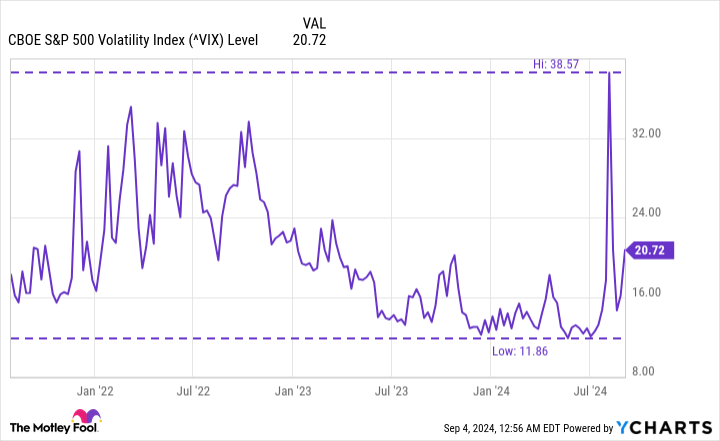Rarely is there a dull month in the stock market, and August proved to be another example. During the first few trading days of the month, the S&P 500 (SNPINDEX: ^GSPC) declined by over 6% alongside a sell-off of major tech stocks, sending the CBOE Volatility Index to its highest levels in years.
The CBOE VIX — known as the “fear index” — measures market volatility and rises during unstable times. There’s no universal CBOE VIX scale, but any number above 30 generally indicates significant fear and uncertainty.
All the commotion around the S&P 500 in early August caused some Wall Street experts to sound the alarm and raise their recession predictions. Admittedly, it’s better to be prepared for a recession that doesn’t happen versus unprepared for one that does, but looking back, these fears were likely overblown and misguided based on just a few days.
Despite the rough start, the S&P 500 recovered the rest of the month and finished August up 2.3%. Those aren’t necessarily eye-popping returns, but it beat its performance in January, April, and July of this year.
The only stock market certainty is uncertainty
The S&P 500’s August roller coaster is a reminder that nobody truly knows how the market will move. You can have all the resources in the world and make educated guesses, but at the end of the day, there’s no definitive way to say how it will perform.
The quicker people learn that lesson, the better their chances of avoiding one of the biggest mistakes in investing: trying to time the market.
It’s easy to want to sell shares when you anticipate the market dropping or load up on shares when you anticipate it rising, but that’s a slippery slope. Even if you’re right once or a few times, timing the market correctly over the long haul is as far-fetched as hitting a bull’s-eye blindfolded.
It’s a habit that you don’t want to form because it typically does more harm than good.
The focus should be on consistency through thick and thin
Volatility is as much a part of the stock market as the stocks themselves. It’s been like that since the beginning of investing, and there’s no reason to believe it won’t be like that for the rest of time. The best thing the average investor can do is focus on consistency; that usually yields the best long-term results.
A great way I’ve found to remain consistent is to use dollar-cost averaging. When you do so, you decide on a set amount to invest, put yourself on an investing schedule, and stick to the schedule regardless of how the market is performing.
For example, let’s assume you have $400 you want to invest monthly into an S&P 500 exchange-traded fund (ETF) like the Vanguard S&P 500 ETF (NYSEMKT: VOO). You could decide you want to divide the $400 into four $100 weekly investments every Monday, two $200 investments every other Friday, or one lump sum at the beginning of each month.
The frequency and schedule you decide on aren’t too important; it’s all about what works for you. What’s most important is that you stick to your schedule no matter what. Having a set schedule reduces the temptation to make sporadic moves based on short-term market movements (or at least that’s the goal).
So, should you invest in the S&P 500?
Few investments are great at any time, like an S&P 500 ETF. It’s a one-stop shop that can be the cornerstone of virtually any investor’s portfolio. The S&P 500, like any other stock or index, has its ups and downs, but it’s hard to go against its historical results.
That doesn’t guarantee it will continue, but decades of solid performance are encouraging.
There are a handful of S&P 500 ETFs, but my personal go-to fund is the Vanguard S&P 500 ETF. Since all S&P 500 ETFs mirror the same index, there isn’t much tangible difference besides cost. With a 0.03% expense ratio, the Vanguard S&P 500 ETF is one of the cheapest ETFs on the market and a third of the cost of the popular SPDR S&P 500 ETF at 0.0945%.
Ignore the noise in the stock market and trust the power of long-term investments in the S&P 500.
Should you invest $1,000 in Vanguard S&P 500 ETF right now?
Before you buy stock in Vanguard S&P 500 ETF, consider this:
The Motley Fool Stock Advisor analyst team just identified what they believe are the 10 best stocks for investors to buy now… and Vanguard S&P 500 ETF wasn’t one of them. The 10 stocks that made the cut could produce monster returns in the coming years.
Consider when Nvidia made this list on April 15, 2005… if you invested $1,000 at the time of our recommendation, you’d have $630,099!*
Stock Advisor provides investors with an easy-to-follow blueprint for success, including guidance on building a portfolio, regular updates from analysts, and two new stock picks each month. The Stock Advisor service has more than quadrupled the return of S&P 500 since 2002*.
See the 10 stocks »
*Stock Advisor returns as of September 3, 2024
Stefon Walters has positions in Vanguard S&P 500 ETF. The Motley Fool has positions in and recommends Vanguard S&P 500 ETF. The Motley Fool has a disclosure policy.
Here’s How the S&P 500 Performed in August. (Hint: The Experts Weren’t Predicting It When the Market Dipped.) was originally published by The Motley Fool
Read the full article here

